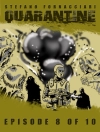Predating Bram Stoker’s ‘Dracula’ by twenty-five years, Sheridan Le Fanu’s ‘Carmilla’ is one of the earliest examples of vampire fiction; a Gothic novella narrated by a young girl who becomes a victim of the title character, a female vampire named Carmilla.
The plot centers on Laura, an English girl living in Austria with her father, a retired and wealthy widower. As a child, Laura had dreamed of a nocturnal visitor, a phantom-like young woman who stole into Laura’s room and drew blood from her. Years later, when a carriage accident outside their home causes Laura and her father to take in the survivors of the accident – a woman and her daughter – Laura is stunned to discover that the daughter is identical to the young woman in her dreams.
As their friendship (and stirrings of romance) begins to grow between the two young women, people around Laura (and eventually Laura herself) begin to suffer from ill health. When the symptoms are recognized as those of a vampire attack, the stage is set for a showdown between Carmilla and the fearsome vampire hunter Baron Vordenburg.
Originally serialized in the literary magazine The Dark Blue from 1871-72, Le Fanu published the full novella in 1872 as part of his story fiction collection ‘In a Glass Darkly’ and the story has since become of the most popular horror stories in literature. ‘Carmilla’ is often cited as an inspiration for ‘Dracula’ and many other horror classics. It is presented here in its original and unabridged format.
Over de auteur
Joseph Thomas Sheridan Le Fanu (1814-1873) was an Irish writer of horror stories, mysteries and Gothic tales and has been hailed as one of the earliest writers of ghost stories, a genre that enjoyed enormous popularity during the Victorian era. Born into a family with strong literary roots (a number of his relatives were writers, including his great-uncle, the playwright Richard Brinsley Sheridan), Le Fanu was also drawn to writing early in his life, but his father was a strict, Calvinist preacher and looked down upon such pursuits. While his family struggled through a series of financial hardships, Le Fanu wound up studying law at Trinity College Dublin, but abandoned this calling to become a journalist. He eventually would come to own several newspapers – including the Dublin Evening Mail – and began submitting short ghost stories to the Dublin University Magazine. After his wife died of a mysterious mental illness, Le Fanu gave up writing fiction until his mother passed away in 1861. But following her death, Le Fanu began producing works at a furious rate, completing ten novels in as many years, along with numerous short stories and novellas, which he collected and published in several volumes. Sheridan Le Fanu died of a heart attack in 1873 at the age of fifty-eight. But his works lived on to inspire an entire generation of horror and ghost fiction writers, including Henry James (‘The Turn of the Screw’), Oliver Onions (‘Widdershins’) and Bram Stoker (‘Dracula’).












